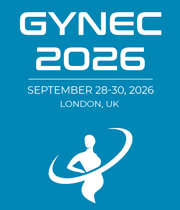Title : Sepsis due to infected necrotic fibroid after uterine artery embolization: A rare but serious complication
Abstract:
Objective: To highlight a rare but serious complication of uterine artery embolization—sepsis secondary to infected necrotic fibroid tissue—and to emphasize the importance of early recognition, multidisciplinary management, and appropriate follow-up in post-UAE patients.
Case report: A 48-year-old P4 woman underwent bilateral uterine artery embolization (UAE) on 15/01/2025 for a large FIGO type 3 submucosal/intramural fibroid (11.2 cm max dimension), aiming to avoid surgery. She presented on 09/02/2025 with a 3-day history of increasing lower abdominal pain, offensive PV discharge with dark tissue, and acute onset of vomiting, diarrhoea, and fever. Examination revealed tenderness without peritonism; she remained hemodynamically stable. She was commenced on broad spectrum IV antibiotics. Blood cultures confirmed Enterococcus faecalis sepsis. Imaging confirmed an embolised fibroid (10.4 × 6.2 × 7.4 cm). Bedside removal of necrotic fibroid tissue prolapsing through the cervix was performed using endoloop sutures. The patient’s condition improved with antibiotics and removal of necrotic tissue. She was discharged on oral antibiotics to complete her treatment. Histopathology confirmed necrosis. Her recovery was uneventful.
Discussion: Uterine artery embolization (UAE) is a minimally invasive and effective alternative to surgery for managing symptomatic uterine fibroids, particularly in women desiring uterine preservation. However, it carries potential risks, including rare but serious infectious complications such as endometritis and sepsis.1 The incidence of infection post-UAE varies, with studies reporting rates ranging from 1.2% to 17%. Severe infections necessitating emergent hysterectomy occur in approximately 0.25% to 1.6% of cases.2
Differentiating post-embolization syndrome (PES) from infection is crucial, as PES typically resolves within 24–48 hours and does not require antibiotics, whereas infections present later and may include offensive discharge, persistent fever, and systemic signs.3 Management of infected necrotic fibroid tissue includes broad-spectrum antibiotics and source control, which may involve removal of prolapsed fibroid fragments via the vagina, hysteroscopic resection, or in severe cases, hysterectomy.4
Conclusion: Sepsis following UAE is rare but potentially life-threatening. This case underscores the importance of early detection, patient education, and timely multidisciplinary management. Clinicians should maintain a high index of suspicion for infection in post-UAE patients presenting with systemic symptoms, and management should focus on appropriate antimicrobial therapy and timely removal of necrotic tissue.




